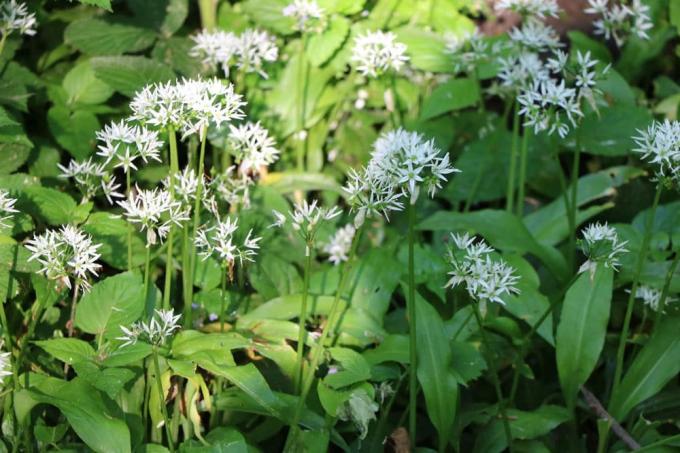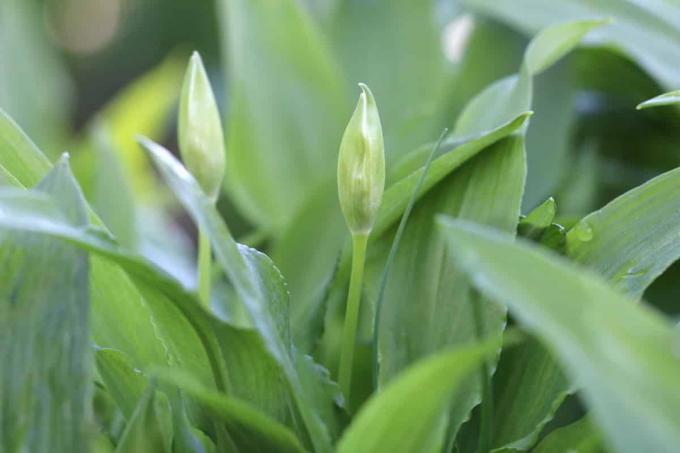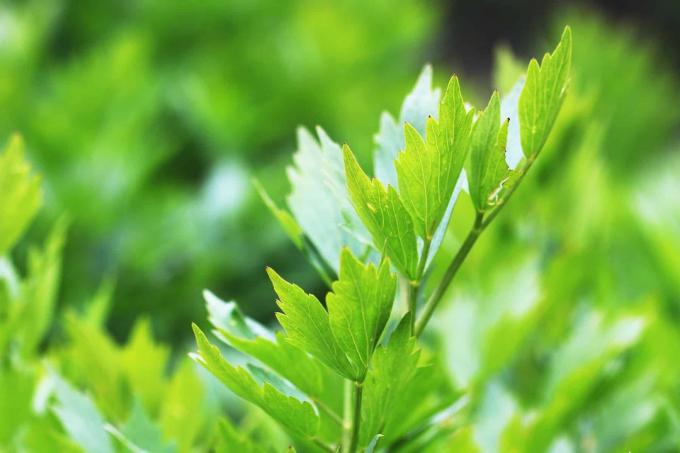

Table of contents
- edibility
- heyday
- harvest
- natural reserve
Wild garlic occurs wild in nature, but the plant can also be planted in the home garden. Over time, the opinion has prevailed that wild vegetables should no longer be eaten after they have blossomed, as they then become poisonous. However, this thesis is not entirely correct, although some things change in terms of taste with the onset of flowering.
edibility
Wild garlic is a native plant and has a particularly delicate and spicy flavor that is subtly reminiscent of garlic. Fresh wild garlic leaves are particularly suitable for salads. Since the cultivation of wild garlic is relatively easy, it can also be found in many domestic gardens. The spicy plant grows wild in the local forests and is mainly found on the edges of fields. Over time, the rumor has spread that wild garlic is poisonous during and after flowering. However, this is not true, not a single component of wild garlic is poisonous, regardless of the season and the state of the flowers. However, there are big differences in quality depending on when the wild vegetables are harvested.
- Also known as wild garlic
- All parts of the plant are safe to eat
- No matter what time of year they are harvested
- Young and fresh leaves have the most intense taste
- Buds are also flavorful and edible
- Can be used just like the leaves
- However, leaves from flowering plants no longer taste as good
- Leaves become fibrous and unsightly by the time flowering begins
heyday
Wild garlic is one of the most popular spring herbs and starts developing its leaves and flowers very early. Since wild garlic looks very similar to many other plants, some of which are poisonous, caution is advised. Therefore, a sample should be made before consumption to be absolutely sure that it is actually the desired wild vegetable. To do this, rub a leaf firmly between your fingers. If there is a garlic-like smell, then it is definitely wild garlic. If this is not the case, then the plant is better not consumed.
- Flowering begins around April
- White inflorescences then form
- Flowers grow in a star shape
- Also have a spicy taste
- With the flowering period, the aroma of the leaves migrates into the flowers
- Flowers can be used as a decoration for dishes
harvest

Wild garlic is one of the earliest wild plants to be collected throughout the year. If this grows in a sheltered place in the garden, then it forms its spicy-tasting leaves at the beginning of spring. Theoretically, wild garlic can be harvested from spring to autumn, because the plant is not poisonous at any time of the year. Although the rumors persist, they do not correspond to the facts. Even after flowering, the wild vegetables are still edible. Nevertheless, wild garlic should be harvested before or during the flowering period, as leaves become increasingly fibrous after flowering and gradually lose their taste. Freshly harvested leaves only keep for a few days, but with the right methods they can be preserved for later consumption.
- In many places, the first tender leaves appear as early as the beginning of March
- The ideal harvest time is from March to the beginning of May
- Harvest in the early hours of the morning when the leaves are particularly juicy
- Only collect from large stocks
- Harvest only one or two leaves per plant
- Cut off the leaves and don't tear them out brutally
- Protect plants and do not trample them unnecessarily
- Collect in nature away from paths
- Can be preserved by freezing and drying
- You can also pickle it in vinegar or oil
Tip:
If the wild garlic leaves are wrapped in a damp tea towel after harvesting, they will stay fresh and flavorful in the refrigerator for up to a week.
natural reserve
It is best to grow wild garlic yourself and only pick your own wild garlic. If you want to harvest wild garlic in the wild, it is not that easy and there are a few rules that must be followed.
IMPORTANT:
If the wild garlic is in a nature reserve or area protection area, there is an absolute ban on picking it!
As with all wild plants (mushrooms, wild berries, wild herbs...) there is a need for a "reasonable reason" to take something from nature. A recognized reason includes: A "Hunger". That's why you should definitely only pick as much as you really need without destroying the plant. So that the wild garlic is not affected, you should not harvest more than one leaf per plant so that it can continue to live.
 garden editorial
garden editorial I write about everything that interests me in my garden.
Learn more about using kitchen herbs

Harvest, dry & freeze lovage: this is how it's done
Lovage (Levisticum officinale) is a popular culinary herb. Unfortunately, freshly harvested, it does not keep for long. However, there are methods to significantly increase the shelf life for longer storage. The right time for harvesting is also important for this.

Preserving bay leaves: Harvest, dry and freeze bay leaves
A number of dishes can be refined with the spice laurel, which is why more and more amateur cooks are cultivating the little tree at home. If you would like to have the aromatic leaves in stock, you can preserve them in just a few steps.

Sow, plant and harvest parsley correctly
Parsley is bitchy? Yes indeed! In the article you will learn how to get the bitch tamed - which is definitely worth it, only very fresh parsley is the real taste and vitamin booster.

14 kitchen herbs that you can really keep in the kitchen
Sometimes a herb garden is only possible on the windowsill. If you don't have your own garden bed, for example, or in the months when the frost freezes the coveted greenery outside. Our list provides an overview of which herbs like the kitchen location permanently.

Insect species: which insects are there in Germany?
In Germany there are around 30,000 species of insects in various shapes and colours. Of these, there are some that are better known than others. In this article you will find a large list of native insects that shape the image of the country.

Drying fresh herbs: make your own spices
Herbs bring freshness and flavor to the table. They are used in cooking and medicine, both fresh and dried. Cultivation is uncomplicated and possible even in the smallest of spaces.

